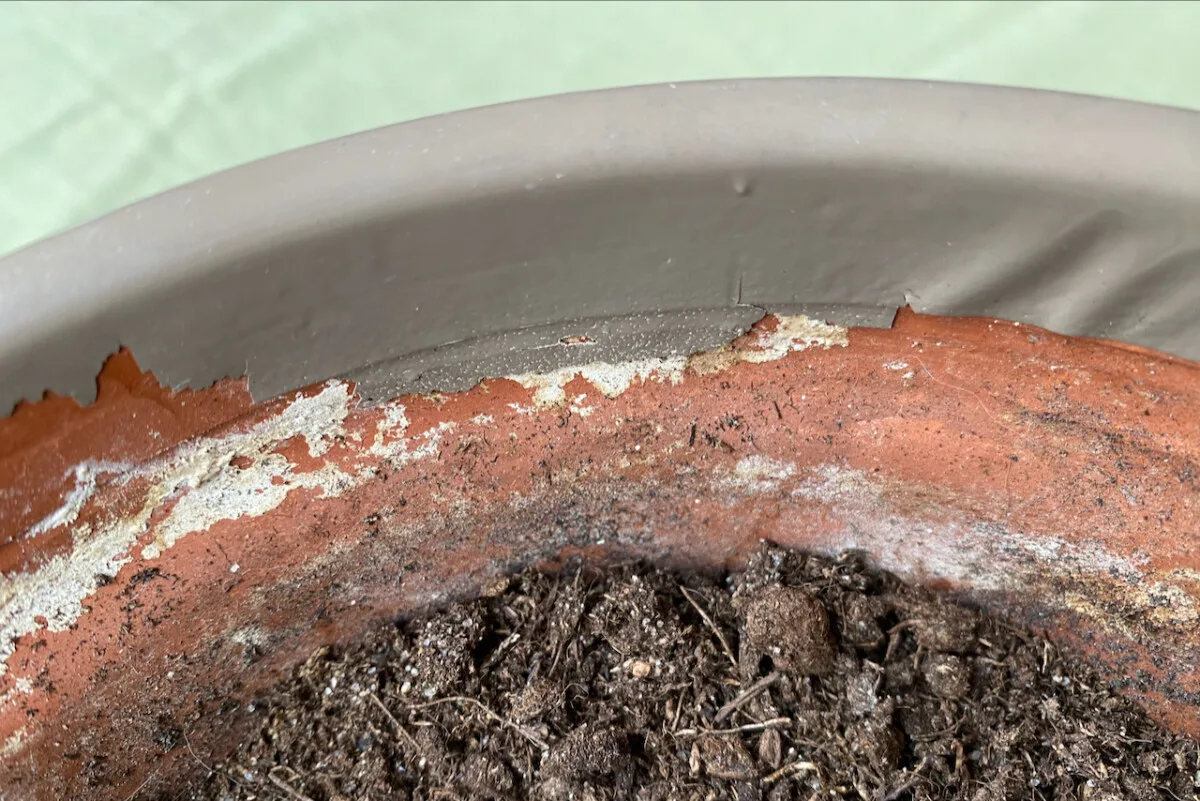
I’m a big believer in the fact that plants are excellent communicators. Not in a weird “I talk to my houseplants every morning” kind of way; more in a “I read the signs and interpret them to the best of my knowledge” manner.
Fortunately, this knowledge comes from experience, so most of my plants are thriving, most of the time. Unfortunately, I may have killed a few plants while acquiring said knowledge and skills.

One of the things I had to learn the hard way was how to deal with the salt that accumulates in houseplant potting soil. Yes, just when I’d thought I had watering, light, moisture and aeration all in check, out comes another factor that may interfere with the growth of my plants.
Luckily, every problem has a solution. And the solution in the case of a salt buildup is quite simple: leaching. Let’s see what that means.
How do soluble salts get to houseplants?
Soluble salts are minerals that we can find in water, either naturally or through added processes before the water reaches our taps. According to an article from the University of California Cooperative Extension, these naturally occurring salts are sodium, chloride, boron, calcium, and magnesium. The same source also notes that fertilizer also turns into a soluble salt when we dissolve it in water.

So there you go! Salt gets in the soil through the simple process of watering. I live in an area with hard water, so I noticed how much faster the buildup happens here than in previous places I’ve lived.
The problem isn’t salt per se, which is beneficial to plants when it occurs in small quantities. The problem is the accumulation of too much salt.
As the salt becomes more concentrated in the soil, it interferes with the absorption of water. The roots get inadvertently “cured” in the salt, so the plant starts dehydrating even when we water it enough.
What are the signs that my houseplants need leaching?
There are two main signs that will indicate to us that there’s too much soluble salt buildup in the soil.
Sign 1: The plant starts getting burned tips.
When the plant can’t absorb water through the roots because of the high levels of salt in the pot, it might start to look thirsty and wilted. Or it may even start dropping healthy lower leaves.
But I found that the best way to diagnose salt buildup is by looking at the tips of my houseplants. If the tips look brown and burnt, then I need to leach the plant. The main reason it shows up in the tips is because that’s where water travels last. If the water absorption is impeded, the tips will not get any, so they’ll die.

I noticed that in plants with pointy tips, such as spider plants, dracaena and certain types of snake plants, the signs tend to be more obvious than in houseplants with rounded edges. Still, even the curvy edges of a monstera, for example, can suffer from dehydration due to salt buildup.
Luckily, if I catch it early, this is merely an aesthetic problem. Once I’ve solved the underlying problem – by either leaching or repotting the plant (in advanced, and particularly salty, cases) – I usually remove the dry tips. I simply cut off the brown part in a V-shape to resemble the original leaf shape.
Sign 2: You can see the salts on the pot or in the soil.
This one is easy to ignore, especially if you like the old patina look that terracotta and ceramic pots get after a while. (I’m definitely a fan of this.) But that patina is merely dry salt that has deposited on the pot.
You’ll notice that the buildup is even more visible on unglazed terracotta, because the salt goes through the walls of the porous material and comes out on the exterior. We often tend to miss it on glazed pottery, because the salt stays underground, blocked by the glazing. However, you can see it at the top of the container.

Interestingly (for a plant geek, anyway), I have this glazed terracotta pot where the salt infiltrated between the terracotta and the glaze, causing it to come apart. Let’s just say I’m not a big fan of glazed or painted terracotta.
In more extreme cases, this powdery salt buildup will travel up the stem as well. Here’s what it looks like on the stem of one of my mature dracaena plants. I’ve since repotted the plant, so there’s no salt in the soil anymore. But the stem is slightly bleached.

How do I leach my houseplant soil?
Here’s how to get rid of the excess salt in the soil of indoor plants. But before you start, make sure you scoop out any layer of salt, if there’s any visible. It looks like a fine, white crust, almost like powdered sugar sprinkled on the surface.
Step 1: Water the plant thoroughly and let it drain.
Place your pot under the tap, then allow running water to run through the soil until it comes out of the drainage holes. You need a bit of water pressure, so not a trickle, but not so strong that it blows soil out of the container.

You don’t need to overdo it. A couple of minutes of this operation, tops, should be enough.
Then let it all drain out.
Step 2: Water the plant thoroughly and let it drain (again).
No, that’s not a mistake. The instructions are the same, on purpose. After all the water has had time to drain out – say, ten minutes to half an hour, repeat the procedure.

I used to only do it once. And I think that was enough, for the most part. But I learned that you have to repeat the process in an article from the University of California Cooperative Extension.
The explanation is that the first watering session serves to dissolve the salts. The second time, you’re flushing them out of the soil.
How often do I need to leach my houseplants?
I’ll admit that this task has never been at the top of my houseplant care list. So I do it whenever I notice there’s a need for it (see the two signs above). That usually translates to once every five or six months.
There are exceptions though.
Obviously, I won’t need to leach a pot if I’ve recently repotted it or refreshed the soil. There should be no buildup in fresh potting soil for at least a few months.

Logistically, some plants get leached less often than others. I need to move my bigger houseplants to the bathtub to do it. So I either end up doing it less often. Or I couple it with the deep dusting that I do every couple of months when I give the mature plants a nice shower.
Generally, I would say having that on your radar at least a couple of times a year is good practice.
How do I avoid salt buildup in my plant’s soil?
We can’t totally avoid it, that’s the trick. Unless perhaps we exclusively use rainwater and never fertilize plants. But even rainwater contains trace minerals that it picks up from the environment.
But there are a few things we can do to slow down the buildup.
Don’t use too much fertilizer.
Over-fertilizing, especially if you’re using synthetic fertilizing, is one of the main causes of a fast buildup of salt in the pot.
When fertilizer dissolves in water, it turns into soluble salt. The water is either absorbed by roots or evaporates, but the soluble salts stay behind.

This isn’t an apparent problem right away. But in time, as we continue to water and fertilize the plant, these salts take up more and more space in the pot. They form a salt buildup.
Organic, plant-based fertilizers (for example, seaweed-based or fish-emulsion) might be a better choice. Check out this article I wrote about the different types of fertilizers for houseplants and the pros and cons of each.
Change the way you water houseplants.
I talked before about this bad habit that I had, just chucking water in the pots whenever I happened to need to dispose of a glass of water. That’s not a good strategy.
A much better method is to soak the plants thoroughly until some of the water drains out through the bottom of the pot.

Then take the next step and empty out the drip saucer. If you’re watering from below, empty out the saucer if you notice that not all the water has been absorbed after about an hour. If you don’t, you’ll end up with drip plates looking like this.
Leaching is a temporary solution.
Ultimately, I think of this process as a temporary fix until I get the chance to repot my houseplants. It’s not a perfect solution, and I know I’ll not remove every bit of salt by leaching the soil. But it’s a solution that buys me some time and an easy enough fix if the plant is really struggling.

Get the famous Rural Sprout newsletter delivered to your inbox.
Including Sunday musings from our editor, Tracey, as well as “What’s Up Wednesday” our roundup of what’s in season and new article updates and alerts.


